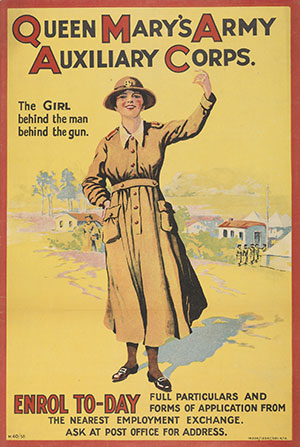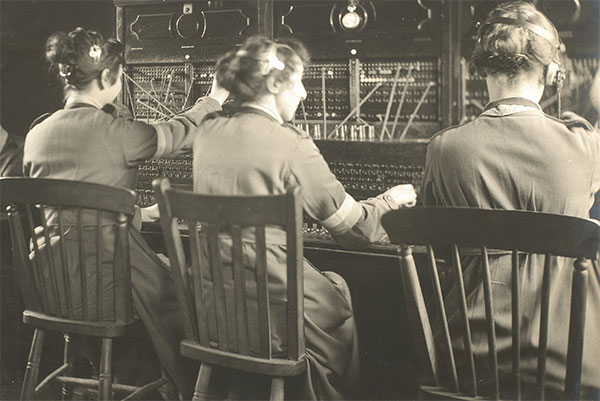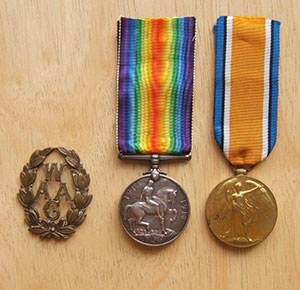Armistice Day
Published in Features, Issue 6 (November/December 2018), Volume 26, World War IArmistice Days in Dublin as viewed by ex-members of the Irish command of WAAC/QMAAC 1917–19.
By Barbara Walsh
On 11 November 1924, four young Irishwomen carrying a wreath headed for College Green in Dublin to attend a Great War Armistice Day ceremony. One wore her First World War army uniform. All were former members of the WAAC/QMAAC—the Women’s (later Queen Mary’s) Auxiliary Army Corps, set up in 1917 to release trained men from basic tasks in bases on the Western Front.
It is often overlooked that Irish women were as eager as their English sisters to enrol. They worked as hostel matrons, cooks and catering staff, office workers or transport drivers. Female post office workers from Irish exchanges were seconded to Royal Engineers’ signal units in France; other young women participated in top-secret cryptanalyst and code-breaking tasks.
Drawn from every stratum of society
The volunteers were drawn from every stratum of society, and Irish women from working-class or farming backgrounds, Protestant and Catholic alike, were as much in evidence in those army bases as were the daughters of well-heeled middle-class and gentrified Anglo-Irish families from Dublin, Cork and Belfast.
The WAAC/QMAAC Irish command HQ was based in Dublin. They supplied staffing for several city barracks and for the Officers’ Training Corps in Trinity College, and oversaw camps of WAACs in the garrison towns of Newbridge, Fermoy and Ballyshannon. The First World War had already witnessed hundreds of Irish nurses and Volunteer Aid Detachments (VADs) toiling in field hospitals and ambulance services (HI 14.5, Sept./Oct. 2006, pp 8–9).
For those former WAAC ‘old comrades’ who had planned to meet at Trinity College with their wreath at 10am on 11 November 1924, that morning’s ceremony was to be a memorable event—the unveiling of a Celtic cross in College Green to commemorate the war’s fallen soldiers of the 16th Irish Division. When later recalling the experience for their QMAAC Associations’ Old Comrades Gazette, they had been surprised to find that that morning’s ceremony had generated ‘a dense and unexpected crowd—which is rumoured to have been between 50,000 and 100,000’.
Indeed, that morning’s crush of people was so great that one of the women afterwards complained that all she saw of the ceremony was ‘the back of a policeman’, while another ‘got lost in the crowd’ and then spent the rest of her time ‘rescuing two children from being trampled on by bringing them to a St John ambulance station’. Fortunately, their uniformed companion fared better: ‘I managed to struggle on to get near to the cross in order to take my place when called upon to place our wreath. We were seventh on the list.’
The event had been a deeply emotional occasion:

Above: Parade of Queen Mary’s Auxiliary Army Corps (QMAAC), Dublin staff unit, Irish command, 1918. (National Army Museum, London)
‘It was a day for us to remember. No one who has lived in Ireland during the happenings of the past few years could have imagined that such a heartening and impressive sight could have been witnessed in the capital of the Irish Free State. The silence was solemn and unbroken. General Hickie unveiled the cross and afterwards the crowds, in jubilant mood, were cheering for everybody and everything. The cross has now been removed and is to find a permanent resting-place in Guillemont.’
The Guillemont cemetery was just a few miles from the site of the Battle of the Somme.
Next morning the Irish Times reported that ‘hundreds of ex-service men, wearing their ribbons and medals [gathered] round the Celtic cross in addition to those who took part in the official parades’, and that ‘after the Réveille had been sounded the National Anthem was sung publicly and lustily in the streets of Dublin for the first time for many years’, an observation tactfully omitted from the women’s report.
Undercurrent of competing ideologies
For the readers of the Irish Times and others of like mind, such incidents evidenced the continued undercurrent of competing ideologies in the new Free State. Pro- and anti-Treaty opinions were still strong; Southern unionists still grappled with change and it is more than likely that these Dublin women were reluctant to get involved in rancorous arguments over the rights and wrongs of the symbol of the poppy. They would have viewed their sale on Armistice Day not only as a mark of mourning for lost relatives, friends and former army colleagues but also as one that funded the work of a charity (first set up for Great War American veterans) that aimed to raise money to aid wounded survivors of all nationalities—their ‘old comrades’, men and women alike.
In 1926 an Irish branch of former WAACs, ‘QMAAC Old Comrades Association’, was founded with the aim of renewing and strengthening the bonds of wartime friendships. The war had shattered many lives and families. Membership covered all 32 counties. Networking was encouraged and their branch offered support to anyone later experiencing periods of ill health or hard times. Following demobilisation in 1919, many ex-WAACs had married ex-servicemen; there had been encouragement to create new lives abroad but there had also been loneliness and poignant outcomes for those left at home, such as one heartbroken former WAAC from Kildare who had lost two brothers and a fiancé in the war. Left only with her love for horses but disillusioned and fearful for the future of Ireland, she had ‘sold up her farm in Ireland to go and live in a country where she could ride’. Others, although less devastated by loss, struggled cheerfully to come to terms with change. For some, to have secure employment at home was a bonus. One wrote in 1921 that:
‘I am in a Government job, in the Treasury, and work in Dublin Castle behind barbed wire and bayonets. I can’t be more definite here, but it’s not really quite as thrilling as it sounds.’
Two years later she had become a staff member of a large Dublin secretarial training college. ‘We are teaching the young to the accompaniment of bursting bombs and whistling bullets’—adding stoically that ‘it is all in the game’.

Above: First World War QMAAC recruiting poster, 1918. (IWM)
Another south Dublin woman, who had worked in France as a forewoman clerk at one of the BEF (British Expeditionary Force) military bases, slipped back into her former government post quite easily, while a telegraphist from a North Circular Road Catholic family returned safely to the GPO in Dublin after almost two years of war service in a signals unit in Le Havre. Two Belfast exchange telephonists—both accomplished French linguists—could likewise resume secure careers. Not everyone was so fortunate, however. Work was scarce, especially for women.
One of the responsibilities of each ‘Old Comrades’ sub-branch across the world was to undertake the annual laying of a wreath on Armistice Day. There is no record to show whether the four friends attended the ceremony on the following year, 1925. It is possible that they had heard rumours of threatened street violence, as there had been a spate of ‘poppy-snatching’ in the city. Newspaper accounts refer to ‘hand-to-hand fighting’ during which ‘blackthorns and hurleys were brought into use’.
Moved to Phoenix Park
The event moved to the Phoenix Park in 1926 to avoid similar scenes. The women once more attended and reported a ‘huge crowd’ gathered around the Wellington monument, where a temporary structure—described as a ‘cenotaph’—was erected for the occasion. It was announced that morning that the wooden cross that stood in Guillemont to honour the Irish war dead had been replaced that summer by a permanent stone cross, described as ‘a simple cross of Celtic design, very weather beaten and worn, having withstood battle and storm all these years’. Space was allocated for six ex-WAAC members, one of whom laid a wreath at the foot of the cross on behalf of former wartime colleagues—no doubt especially remembering Irish WAAC casualties too. According to the women’s account, ‘When the Last Post was sounded, the silence was as absolute as that round the Cenotaph in Whitehall’. The original wooden cross was to be nostalgically displayed during the Dublin ceremonies for many more years after this.
In the meantime the women continued to meet regularly to fulfil social and hidden duty-bound tasks that required discretion and tact. An early SOS was sent out in 1923 asking whether any ‘old comrades’ living in Cork could help a former servicewoman in that area, and in 1928 the Irish branch swiftly rallied to the aid of an ex-WAAC ‘married to an ex-serviceman’ with a family of small children, one of whom was ‘tubercular’. The family were ‘very badly off owing to the husband losing his work through ill-health’.
In 1935 their report on the Phoenix Park Armistice Day ceremony comments that ‘The attendance was good … Even in these days great crowds always gather to keep the two minutes’ silence.’ In November 1936 ‘the rain had come down in torrents and the march past had to be abandoned’, and in 1937 the construction of a new memorial park (at Islandbridge) was being ‘delayed by a builders’ strike’. Nonetheless, that year saw the introduction of an innovative way of marking the day. A section of ground in the Phoenix Park adjacent to where the old Celtic cross stood had been divided up into plots for each county in Ireland. Those attending the ceremony could purchase a small cross that could be placed in their chosen county. At the end of the week all the crosses were collected, taken to France and burned, and the ashes were scattered over the graves of the Irish dead. The crowds ‘who came to remember their dead were as dense as ever [and] the band played Schubert’s Ave Maria as wreaths were laid’.
Change was in the wind, however. In spring 1938 the Irish branch was renamed the Éire or Free State branch (later simplified to ‘Southern Ireland’) and a new Northern Ireland branch was founded. Far from causing a split, close co-operation saw memberships increase and links being strengthened. Old pals now had the excuse to travel up and down between Dublin and Belfast for special occasions. When a member from Coleraine Post Office was promoted to the exchange in Holywood, Co. Down, Dublin members recalled how they had spent service years with her in Le Havre and St Omer.
By 1938 Armistice Day attendees are shown to be in sombre mood:
‘There seemed to be more wreaths this year; perhaps the shadow of war which so lately hung over us bestirred us to help those who had survived and suffered from the horrors of the last war’.
Twelve months later, neighbouring Britain was embroiled in the grim reality of the Second World War. Remembrance Day still went ahead in the Phoenix Park, however. Members of the diplomatic corps attended. Regimental standards were flown. But ‘ex-servicemen did not march’ and ‘there’d been a complete absence of show and parade’.

Above: Female post office workers from Irish exchanges were seconded to Royal Engineers’ signal units in France; other young women participated in top-secret cryptanalyst and code-breaking tasks. (National Army Museum, London)
Irish National War Memorial Gardens, Islandbridge

Above: A hat badge and war medals awarded to a WAAC member who served in France 1917–19. (Barbara Walsh)
In 1940 the two-minute silence and low-key ceremony were held for the first time in the new Irish National War Memorial Gardens at Islandbridge. Funded by both the state and public subscriptions, the new setting and monument—designed by Sir Edward Lutyens—was described by the women in their 1942 report as ‘beautiful, although simple in design’. Music for the ceremony began with Chopin’s Funeral March. Bugles sounded The Last Post.
In 1948 the women of the Southern Ireland branch of what had been formerly the ‘QMAAC Old Comrades’ Association’ were once more stirred to report on events at the Memorial Gardens in Dublin. By then middle-aged or older, their association was now merged with that of new comrades known as the Auxiliary Territorial Service (ATS), because Irishwomen had been drawn into that later conflict too. In 1948 our women note that:
‘In spite of the inclement weather, on 7 November, about eighteen ex-ATS marched with ex-servicemen to the Memorial Park, Islandbridge, Dublin’.
One can only imagine their thoughts on seeing uniformed women that morning. Thirty years earlier, in the hope of ending the slaughter of so many young people in that terrible war, they had left the safety of jobs as civil servants and governesses, cooks, teachers, waitresses and post office workers.
Barbara Walsh’s From Western Front to Roaring Twenties: the forgotten story of Irishwomen’s First World War army service will be published shortly.
FURTHER READING
S. Bidwell, The Women’s Royal Army Corps (London, 1977).
A. Marwick, Women at war 1914–1918 (London, 1977).
R. Terry, Women in khaki (London, 1988).
















